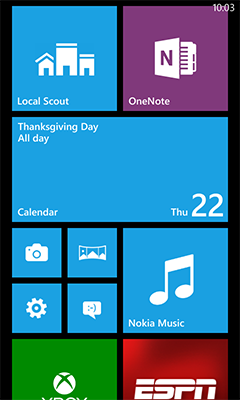| Company / developer | Microsoft Corporation |
|---|---|
| Programmed in | C, C++ |
| OS family | Windows |
| Working state | Current |
| Source model | Closed-source |
| Initial release | |
| Latest stable release | Windows Phone 8 (8.0.10211.204) / December 20, 2012 |
| Available language(s) | 25+ languages |
| Package manager | Windows Phone Store XAP on Windows Phone 8 and later |
| Supported platforms | Qualcomm Snapdragon (Based on ARM V.7 or later) |
| Kernel type |
Monolithic (Windows CE) (Windows Phone 7) Hybrid (Windows NT) (Windows Phone 8) |
| Default user interface | Graphical (Metro UI) |
| License | Commercial proprietary software |
| Official website www.windowsphone.com | |
| Windows Phone (abbreviated as WP) is a series of proprietary mobile operating systems developed by Microsoft, and is the successor to its Windows Mobile platform, although incompatible with it. Unlike its predecessor, it is primarily aimed at the consumer market rather than the enterprise market. It was first launched in October 2010, with a release in Asia following in early 2011. The latest release of Windows Phone is Windows Phone 8, which has been available to consumers since October 29, 2012. With Windows Phone, Microsoft created a new user interface, featuring its design language called the Modern design language. Additionally, the software is integrated with third party services and Microsoft services, and sets minimum requirements for the hardware on which it runs. Microsoft is currently developing the next version of Windows Phone, code named "Windows Phone Blue" (previously "Windows Phone Apollo Plus") which will either be named Windows Phone 8.1 or Windows Phone 9 Launch and expansionWindows Phone 7
Main article: Windows Phone 7
Windows Phone 7 was announced at Mobile World Congress in Barcelona, Spain, on February 15, 2010, and released publicly on November 8, 2010 in the United States.Microsoft released an updated version of Windows Phone 7, Mango (also referred to as Windows Phone 7.5), in May 2011. The update included a mobile version of Internet Explorer 9 that supports the same web standards and graphical capability as the desktop version, multi-tasking of third-party apps, Twitter integration for the People Hub, and Windows Live SkyDrive access A minor update released in 2012 known as "Tango", along with other bug fixes, lowered the hardware requirements to allow for devices with 800 MHz CPUs and 256 MB of RAM to run Windows Phone. In January 2013, Windows Phone 7.8 was released. It added some features from Windows Phone 8, such as an updated start screen, doubling of the color scheme options to 20 and the option to have the Bing image of the day as the lock screen wallpaper. Windows Phone 7.8 was intended to prolong the life of older Windows Phone 7 devices, as these were not upgradable to Windows Phone 8 due to hardware limitations. However, not all users have received the Windows Phone 7.8 update yet. Microsoft has announced that Windows Phone 7.8 will see further future updates and as both Windows Phone 7 and Windows Phone 8 will coexist for sometime, to support devices in different price ranges. Windows Phone 8
Main article: Windows Phone 8
On October 29, 2012, Microsoft released Windows Phone 8, a new
generation of the operating system. Windows Phone 8 replaces its
previously Windows CE-based architecture with one based on the Windows NT kernel with many components shared with Windows 8, allowing applications to be easily ported between the two platforms.Hardware supportWindows Phone 8, while adding a number of software improvements, also brought support for updated hardware. This included support for multi-core processors and high resolution screens. Windows Phone 7 and 7.5 were often criticized for a lack of high end hardware support, but Windows Phone 8's new hardware gave Windows Phone the ability to better compete with GooglePartnership with NokiaOn February 11, 2011, at a press event in London, Microsoft CEO Steve Ballmer and Nokia CEO Stephen Elop announced a partnership between their companies in which Windows Phone would become the primary smartphone operating-system for Nokia, replacing Symbian. The event focused largely on setting up "a new global mobile ecosystem", suggesting competition with Android and iOS with the words "It is now a three horse race". Elop's reasoning behind settling on Windows Phone over Android involved the realization: "the single most important word is 'differentiation'. Entering the Android environment late, we knew we would have a hard time differentiating." While Nokia would have had more long-term creative control with Android (note that MeeGo as used by Nokia resembles Android more than it does Windows Phone 7), Elop enjoyed familiarity with his past company where he had been a top executive.The pair announced integration of Microsoft services with Nokia's own services; specifically:
The first Nokia Windows phones, the Lumia 800 and Lumia 710, were announced in October 2011 at Nokia World 2011 event.[ At the Consumer Electronics Show in 2012 Nokia announced the Lumia 900, featuring a 4.3-inch AMOLED ClearBlack display, a 1.4 GHz processor and 16 GB of storage.The Lumia 900 was one of the first Windows Phones to support LTE and was released on AT&T on April 8. An international version will launch in Q2 2012, with a UK launch expected in May. The Lumia 610 is the first Nokia Windows Phone to run the Tango Variant (Windows Phone 7.5 Refresh) and is aimed at emerging markets. |








.jpg)






0 comments:
Post a Comment